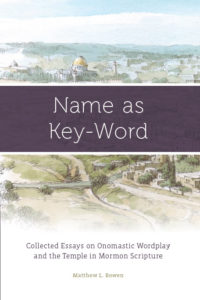
Name as Key-Word:
Collected Essays on Onomastic Wordplay and the Temple in Mormon Scripture
By Matthew L. Bowen
This hard-cover book is available directly from Eborn Books for $22.99. It is also available on Amazon and AmazonSmile for $24.95. (Prices may vary depending on vendor.)
Newly Available from Eborn Books: Two books by Matthew Bowen — Ancient Names in the Book of Mormon and Name as Key-Word: Collected Essays on Onomastic Wordplay & the Temple in Mormon Scripture: $45.00
Throughout the Bible, understanding the meaning of names of important people and places is often crucial to understanding the message of the ancient authors. In other words, names of people and places serve as “key-words” that can help unlock the intended messages of scripture.
Since the Book of Mormon is an ancient record rooted in Old Testament traditions, it is not surprising that similar patterns of wordplay emerge from its pages. Besides their important role as key-words in scriptural interpretation, the names of people and places may also provide our clearest glimpses into the text that existed on the plates from which Joseph Smith translated the Book of Mormon. In many instances, the names of important Book of Mormon people and places are directly related to words matching the most-likely Hebrew and Egyptian origins for those names. Textual and contextual clues suggest that this matching was done deliberately in order to enhance literary beauty and as an aid to understanding. In some cases, authorial wordplay can be verified by a close analysis of matching text structures. In others, the wordplay can be verified by using the Bible as a “control” text.
A wealth of philological, onomastic, and textual evidence suggests that the Book of Mormon, like the Bible, is the work of ancient authors rather than that of a rural nineteenth-century man of limited literary attainments. Knowing more about these names enriches our understanding of the stories that these authors tell.
Table of Contents:
Foreword by Jeffrey M. Bradshaw
Introduction
1. Nephi’s Good Inclusio
2. “Most Desirable Above All Things”: Mary and Mormon
3. Joseph, Benjamin, and Gezera Shawa
4. “What Thank They the Jews?”
5. “And There Wrestled a Man with Him”: Jacob, Enos, Israel, and Peniel
6. Young Man, Hidden Prophet: Alma
7. Father Is a Man: Abish
8. “They Were Moved with Compassion”: Zarahemla and Jershon
9. “See That Ye Are Not Lifted Up”: Zoram and the Rameumptom
10. “He Is a Good Man”
11. My People are Willing: Aminadab
12. Getting Cain and Gain
13. Place of Crushing: Heshlon (with Pedro Olavarria)
14. “In the Mount of the Lord It Shall Be Seen” and “Provided”
15. Founded Upon a Rock: Peter’s Surnaming
16. You More Than Owe Me This Benefit: Philemon and Onesimus
Bibliography
Index


